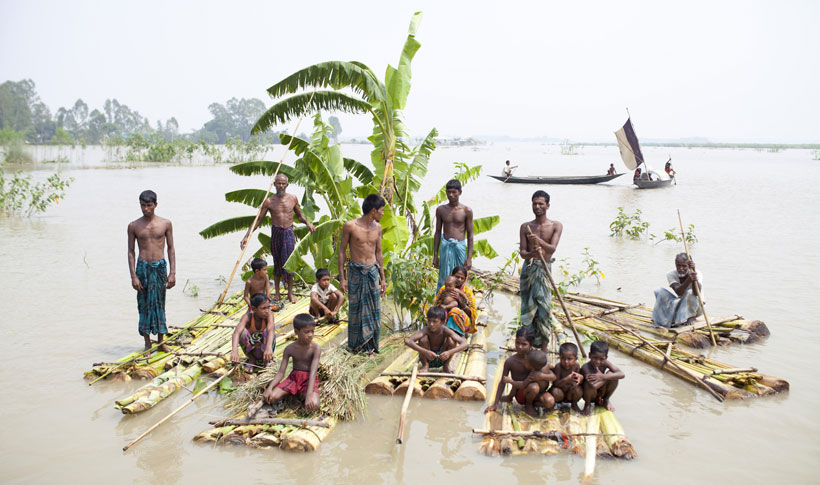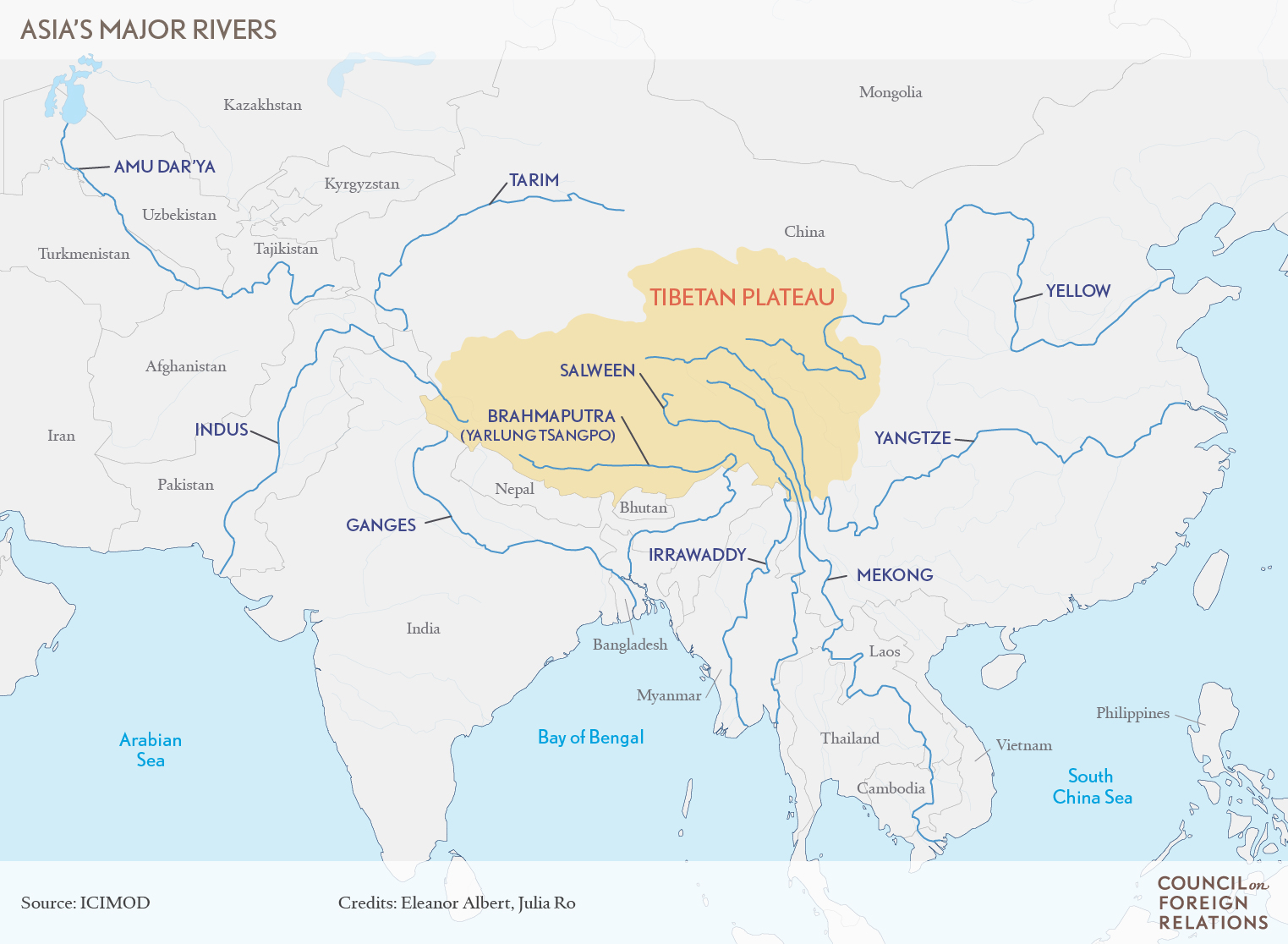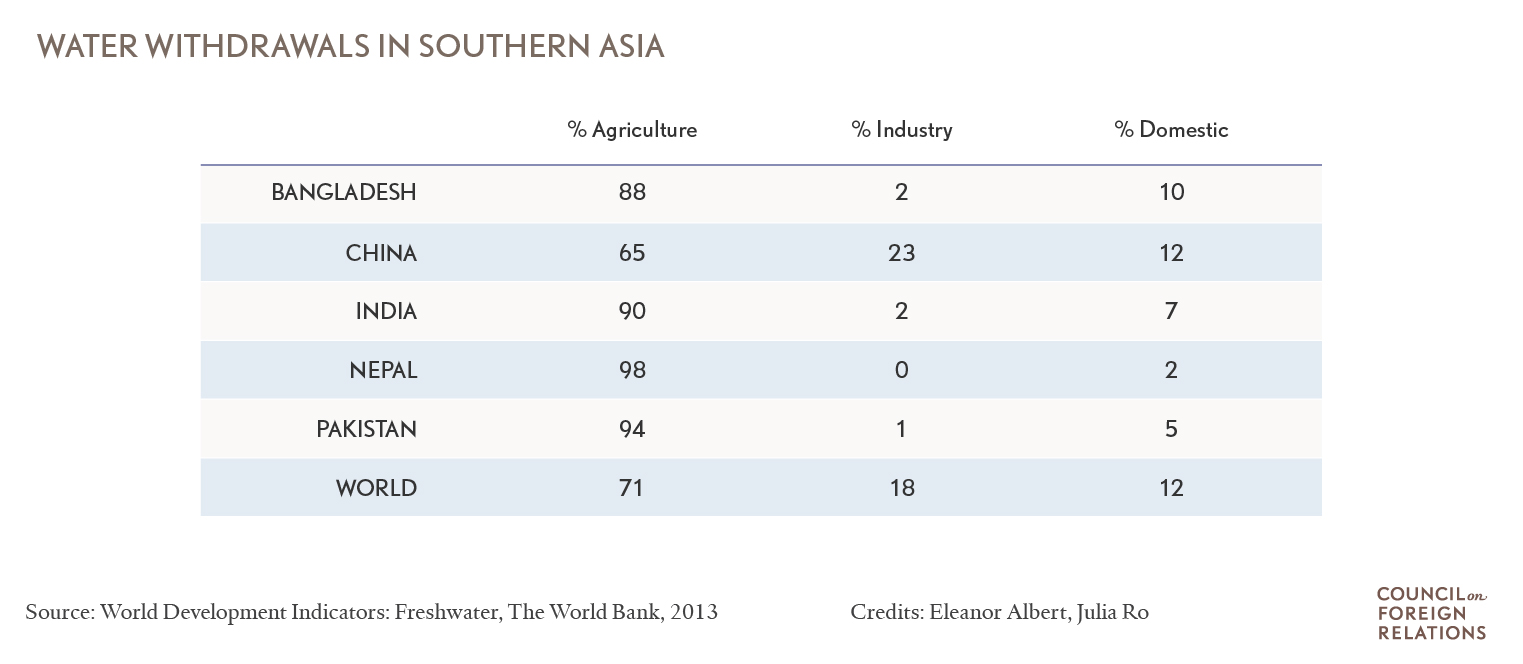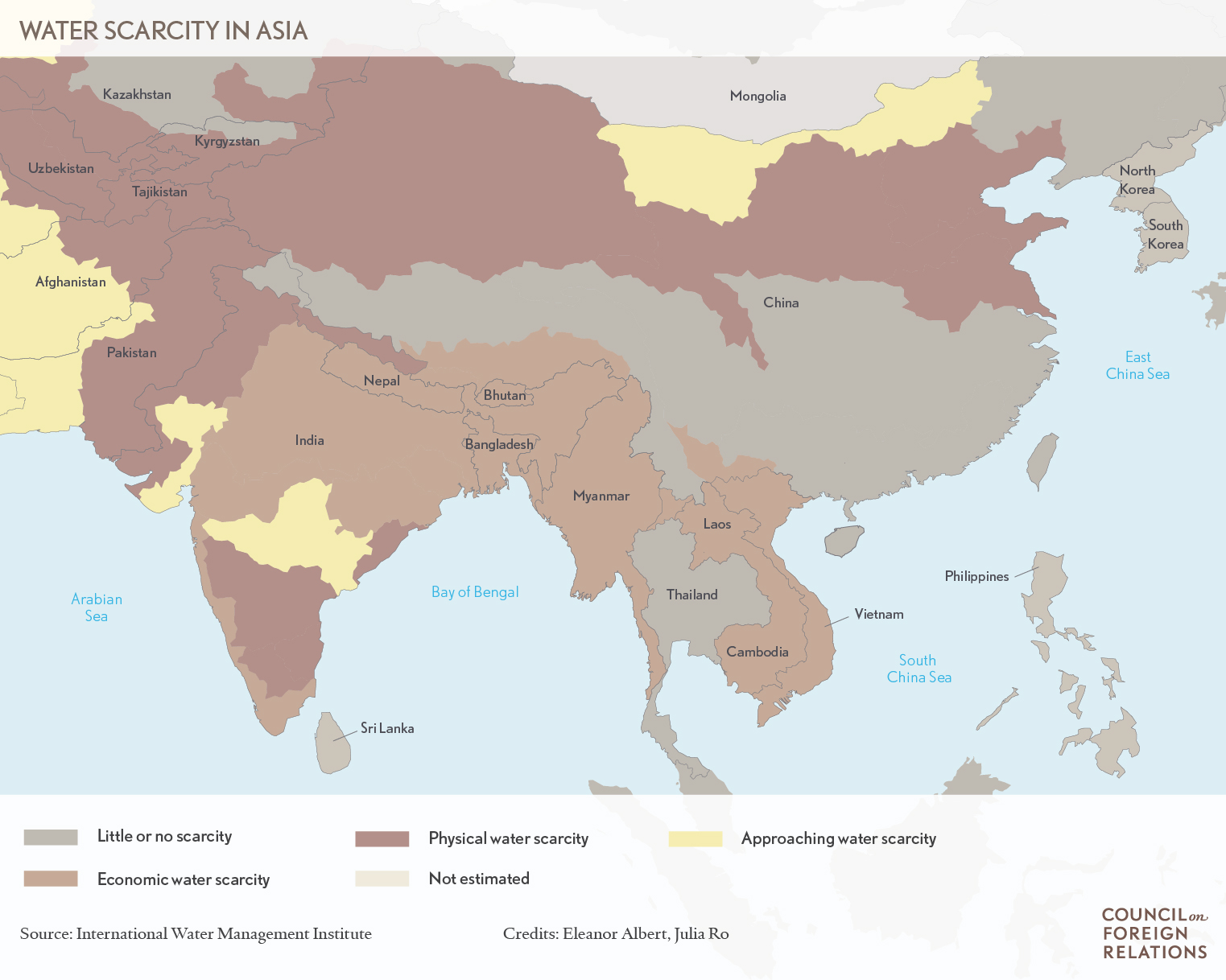By Eleanor Albert for Council on Foreign Relations (CFR)
1 Jun 2016
 Ten major rivers flow from the Tibetan Plateau and provide water to more than 1.35 billion Asians, or 20% of the world’s population. And yes, demand for this water is soaring while Himalayan glaciers are rapidly melting. To Eleanor Albert, this spells trouble unless the area’s nations cooperate more effectively on water management.
Ten major rivers flow from the Tibetan Plateau and provide water to more than 1.35 billion Asians, or 20% of the world’s population. And yes, demand for this water is soaring while Himalayan glaciers are rapidly melting. To Eleanor Albert, this spells trouble unless the area’s nations cooperate more effectively on water management.
This article was originally published by the Council on Foreign Relations (CFR) on 9 May 2016.
Ten of Asia’s major rivers flow from the Tibetan Plateau and fill river basins that provide water to more than 1.35 billion people, a fifth of the world’s population. Demand for this water, propelled by population growth and rapid urbanization, is soaring while supply is under increasing pressure from accelerated melting of Himalayan glaciers and other factors. A water crisis looms. Overall, Asia has the world’s lowest per capita water availability and arable land, according to an Asia Development Bank report. Experts warn that the region needs to improve cooperation on water management soon or run the risk of conflict over water resources.
Why is the Tibetan Plateau important?
The Tibetan Plateau is home to the Himalayas, the world’s tallest mountain range. The Himalayas are at times referred to as the “third pole” because they hold the largest concentration of ice and glaciers outside the northern and southern poles. Glacier melt and mountain springs function as a water tower for billions of people. The waters originating from the plateau feed rivers flowing out of China across continental Asia. Scientists say the Himalayas also influence weather patterns, which help to predict rainfall and flood cycles.
The most critical transboundary river basins formed by Himalayan rivers are the Ganges-Brahmaputra-Meghna, Indus, and Mekong basins, the largest in area and population served. Despite a seeming abundance of rivers in the Himalayan-Hindu Kush mountains, Asia—the most populous continent—has less freshwater available per capita than any other region. The looming threat resonates in the foothills of the Himalayas.
The territory that is home to these rivers, Tibet, has hosted a wide array of Chinese development projects since the launch of Beijing’s “go west” campaign in 2000. These include transport infrastructure, large-scale mining, and dams for hydropower, manufacturing, irrigation, and domestic use. Other riparian states have followed Beijing’s example, pursuing water projects to meet economic targets. In the absence of international institutions and norms to regulate shared water sources and as demand for water grows, control and management of this precious resource is expected to stoke local, subregional, and national tensions.
What countries are affected by Himalayan rivers?
China and India primarily. Both countries are drivers of regional and global economic growth and G20 and BRICS economies. China is the world’s second-largest economy, while India ranks seventh, based on IMF estimates. The two neighbors account for 62 percent of the territory in the Himalayas and benefit from an upstream position.
Scores of upstream water projects underway, such as water diversion or dam construction, may alter the quality and quantity of water available to lower riparian states. While the greater Himalayan region as a whole struggles to deal with growing demand for water, individual countries face different challenges. Some depend on external water flows—for example, Bangladesh, Pakistan, and Uzbekistan have 91.4 percent (PDF), 77.7 percent, and 80 percent dependency ratios (PDF) (the amount of total renewable water resources originating beyond a country’s borders), respectively. Other countries in the region lack water storage capacity or financial means to implement effective water management practices.
What fuels regional water tensions?
The region’s population boom has placed extreme pressure on resources like water. Since 1981, China’s population increased by more than 37 percent to 1.36 billion in 2015, India’s grew by 81.5 percent to almost 1.3 billion, and Pakistan’s by nearly 130 percent to 185 million, according to World Bank figures.
Countries surrounding the Tibetan Plateau are also simultaneously experiencing rapid urbanization with millions migrating from the countryside. Today’s most populous countries—China and India—are expected to have the largest growth (PDF) in urban populations by 2050, according to the United Nations. China is projected to add an additional 292 million to its more than 750 million current urban dwellers; India’s 410 million city residents will nearly double. To meet projected demand for urban dwellers, countries have turned to multipurpose dams.
China, India, Pakistan, and others have plans for hundreds of hydropower facilities along the rivers of the Tibetan Plateau. The Three Gorges Dam, opened on the Yangtze in 2003, is the largest power generating station in the world with an installed capacity of 22,500 megawatts, enough to power more than 18 million homes (PDF). More recently in October 2015, China operationalized what is believed to be the world’s highest-altitude power station, the $1.5 billion Zangmu hydropower facility in Tibet on the Brahmaputra. The Zangmu dam does not store water, but riparian states are concerned that the dam may disturb downstream soil. Chinese firms are also financing or building dams elsewhere, particularly in Laos and Pakistan—countries looking to remedy energy shortages. India and its neighbors have followed suit, building their own dams to secure irrigation and electricity needs.
Planned hydro infrastructure projects throughout Southern Asia have stirred fears from communities downstream of the dams in India, Bangladesh, and Nepal about the environmental impact (PDF). Nimmi Kurian, an associate professor at the New Delhi-based think tank Centre for Policy Research, says the science behind such facilities, largely run-of-the-river dams, is “ill-defined and little understood.” Others say coriparian states fear China will exploit its upstream position. “[Beijing’s] latent capability to control cross-border river flows arms it with significant leverage over neighbors—a leverage it could employ to influence the behavior of those states,” writes the Centre for Policy Research’s Brahma Chellaney.
Among the other concerns expressed by downstream countries are altered water flows, changes in fishing resources, and the displacement of people. Protests have prevented some projects from getting underway in communities in the extended Himalayan region.
Thousands of Chinese protested against the human and environmental costs of China’s Three Gorges Dam, which caused the relocation of about 1.3 million people. Local opposition in Cambodia and Myanmar blocked Chinese-backed dams on the Mekong and Irrawaddy. Indian water infrastructure projects have also roused discord. Villager protests held up dam projects on tributaries of the Brahmaputra and Son rivers over ecological reasons and land acquisition. Major bilateral hydropower deals such as those reached between China and Nepal and India and Bhutan have been met with alarm from activists and experts. Some critics have expressed skepticism about the thoroughness of environmental impact assessments, equity in electricity distribution, and the risks of hydropower hubs along geological fault lines prone to earthquakes and other environmental disasters.
 People waiting for food from flood relief on September 7, 2015, in Kurigram District, Bangladesh, after devastating floods and landslides triggered by heavy rains. (Photo: Zakir Hossain Chowdhury/Barcroft Media UK Office/Getty)
People waiting for food from flood relief on September 7, 2015, in Kurigram District, Bangladesh, after devastating floods and landslides triggered by heavy rains. (Photo: Zakir Hossain Chowdhury/Barcroft Media UK Office/Getty)
Southern Asia’s history of territorial disputes and competition among emerging economies also impede efforts on building a collaborative discourse on water issues. China’s unwillingness to consider resource-sharing agreements is an obstacle to cooperation. But some observers say India has also taken bold actions to secure its water resources, further complicating already fragile interregional dynamics. Governments’ approaches to transboundary water issues tend to focus on infrastructure construction and the effects on downstream flows, experts say, as opposed to a more holistic focus incorporating issues related to environmental and human costs. As China expands its regional influence and as India’s economy thrives, competition for strategic resources, like water, will likely make cooperation even more difficult. “Regional water-sharing problems are fundamentally influenced by existing political tensions” (PDF), says Chatham House, a UK think tank, in a 2014 report.
What is at stake?
Rampant development in the greater Himalayas could lead to further shrinking of available clean water, heightening the risk of displacement, disease, or even conflict. The Asian Development Bank (ADB) estimated that more than 75 percent of the broader Asia-Pacific region suffers from water insecurity, and that South Asia’s problems are severe. The subregion, much of which relies on water from the Tibetan Plateau, supports more than 20 percent of the world’s population but only accesses 8 percent of the world’s water resources. Water is indispensable for activities like energy generation, mining, fishing, and domestic uses like sanitation and drinking water. The principal allocation of water to agriculture emphasizes a vital relationship between water and food security in the world’s most densely populated region.
Agriculture may be the dominant user, but amid rapid economic and urban growth, traditional water usage will fluctuate and competition will intensify. Vested interests are diverting water for industrial projects, including hydroengineering, with little change to water management policies. As a result, Southern Asia is experiencing rising levels of deforestation, soil erosion, elevated pollution, sedimentation, diminishing grasslands, and unpredictable flood patterns.
The Himalayas are also said to be warming more rapidly than anywhere else on the planet. Between 1970 and 2006, permafrost, the permanently frozen layer of earth, shrank by more than 18 percent, and glaciers in China have shrunk more than 10 percent since 2000, according to China Water Risk, a Hong Kong-based nonprofit. Temperatures in the region are forecast to increase 1-2 degrees Celsius by 2050, according to Kathmandu-based nongovernmental organization International Centre for Integrated Mountain Development (ICIMOD). The effects of climate change will continue to alter water availability, scientists and regional experts say. An expected rise in temperatures will lead glaciers to recede faster. Ensuring sustainable water supplies will be further challenged by erratic precipitation.
The variability and unpredictability of water availability will also have implications on Asia’s weather and monsoon patterns. Climate change and warming temperatures appear to be affecting the region differently, based on World Bank research. In the short and medium term, the warming affects will likely exacerbate climatic extremes, lengthen monsoons, and lead to an increasing number of floods, according the ICIMOD’s Himalayan Climate and Water Atlas. Severe floods in Bangladesh, India, and Pakistan in recent years have been devastating. Many countries susceptible to flooding are ill-equipped to manage the influx of water, be it storing excess resources or mitigating contamination when floods hit polluted lowlands and industrial zones.
Added development pressures are affecting water quality. Studies estimate that 80 percent of Asia’s rivers are in poor health. More than two-thirds of sewage discharged into the Ganges river in India goes untreated and an estimated 20 million people are exposed to arsenic-laced water in Bangladesh. India and China top the list of countries with the greatest number of people living without access to safe water, 75.7 million and 63.1 million respectively, based on a March 2016 report from global charity WaterAid. Water pollution has also increasingly been linked to elevated levels of cancer in local communities, especially in China and India.
What are prospects for regional collaboration on water use?
Existing water agreements are few and far between. Instead, “people within communities, states, and nations naturally like to safeguard their [water] supplies,” said ICIMOD Director General David Molden in a written interview. Nevertheless, India has negotiated water-sharing agreements with Pakistan and more recently with Bangladesh. It has also reached deals with Nepal on barrage building, hydropower dams, and flood control. India also provides Pakistan with flood forecast data. In the 2000s, China and India reached data sharing agreements (PDF) on seasonal flood patterns for the Brahmaputra Basin.
More broadly, there is no binding international legal framework to regulate water. The UN General Assembly overwhelmingly passed the Convention on Law on the Non-Navigational Uses of International Watercourses (PDF) in 1997, but as of early 2016 the convention only has sixteen signatories and thirty-six parties—none from the Himalayan region.
In the absence of institutionalized management, civil society has begun to fill the gaps. Regional organizations, such as ICIMOD in Kathmandu, and internationally supported regional groupings, like the Network of Asian River Basin Organizations and the Asia-Pacific Water Forum, have emerged as mechanisms to increase data transparency, improve regional and subregional capacity, provide technical advice, and promote best practices. Independent nonprofits, like the Third Pole, based in New Delhi and London, and International Rivers, based in California, share information and drive discussion related to regional water resources. These organizations have also encouraged scientific collaboration on climate change issues.
Yet most Southern Asian countries lack long-term planning and national approaches to resource management. Chellaney of the Centre for Policy Research writes that the fragmentation of water policy across ministries and central and local authorities “translates into an absence of urgency and accountability.”
How can crisis be averted?
Southern Asia’s economic growth, demographic boom, and appetite for energy are producing conditions for a water crisis. ICIMOD’s Molden says the lack of clean water, limited irrigation water, drying springs, and threat of severe weather incidents are symptomatic of a crisis. In spite of stumbling blocks to regional cooperation, steps can be taken to curtail water pressures.
Institutions like the World Bank and ADB, and newer ones like the Asian Infrastructure Investment Bank, can continue to foster dialogue and promote sustainable water practices. Community-based organizations, provincial and national NGOs, and independent academics and think thanks also have an important role to play pushing governments to pursue greater cooperative efforts, said Joydeep Gupta, South Asia director of the Third Pole, in a written interview. NGOs can mediate disputes, monitor riparian state behavior, and represent voices of locals whose concerns remain unheard.
Experts say revisiting water usage is essential. Communities could shift to less water-intensive crops and irrigation techniques. The same holds true for energy industries: Power companies could move away from water-heavy coal and fossil fuel extraction. Joint hydropower production and ecosystem protection could also build confidence among regional players.
The onus to overcome interstate competition lies with China and India. “A warming bilateral relationship (PDF) is the precondition to closer cooperation on the water issues between China and India,” writes Zhang Hongzhou, an associate research fellow at Singapore’s S. Rajaratnam School of International Studies. Kurian of the Centre for Policy Research also writes that a willingness (PDF) from Beijing and New Delhi to discuss transboundary goods, like water, could present an opportunity to ease water tensions.
About the Author
Eleanor Albert is an Online Writer/Editor for CFR.
For more information on issues and events that shape our world, please visit the CSS Blog Network or browse our Digital Library.



No comments:
Post a Comment